UC Cooperative Extension Master Gardeners played a key role in establishing a vibrant garden behind a church in Livermore that has produced 8,000 pounds of vegetables for the church's food kitchen, reported two MGs in a column published in the San Jose Mercury News.
What was unused vacant land only three years ago has spurred the creation of an independent 501(c)(3) nonprofit organization called Fertile GroundWorks. Fertile GroundWorks has pilot projects under way to help organizations establish and operate new community gardens. The Alameda County Master Gardeners are playing an expanded educational role, the article said.

Urban gardens can produce thousands of pounds of produce.
Posted on
Friday, February 15, 2013 at
8:21 AM
The Christmas tree down, the mistletoe composted, the cards put away, and fudge gone. So finally it is time to curl up with a cup of good, fresh coffee and my huge pile of seed and gardening catalogs which I have been receiving over the past few months. What a treat to relish over picture after picture, description after description of lovely, healthy, and might I add, perfect plants ready to grace my garden this spring. Eye candy on a very cold, gray day.
However, before I go nuts and start ordering everything that calls my name, I must stop, think, and come to my senses, for not all that I see is really what I want and/or need. Precaution must be taken. There are "rules" for ordering from those plentiful books. Just in case you, too, are wanting to go wild, here is a reminder of some common sense guidelines.
First of all, let me say, I prefer catalogs that are printed on recycled paper for obvious reasons. Secondly, I pay more attention to those with photographs of plants, as opposed to those with only drawings. I realize that it is more expensive to produce a book with photos, but I feel I can get a more realistic idea of what I am looking at in a photograph.
Here are some more basic, less personal, things to look for as you drool over the latest offerings:
You should easily be able to ascertain what USDA hardiness zone each plant will do well in by reading the plant description. Words like "hardy"or "tender" are not sufficient. Most catalogs I have seen do include zonal information. Just in case you do not know your own planting zone, you can find it at USDA Hardiness Zone chart.
Listings should include the plants botanical name. This is important for several reasons. Common names for plants can greatly vary. My grandmother in Nebraska may have had one name for a particular daisy, but it is called something different by my next door neighbor here in California. Also, often a seed company will give a flashy trademark name to a vegetable, shrub or flower. However, if you are wanting to research the plant, you need to have its exact, correct name.
General habitat information such as how much water, how much sun and germination time should be easily found. If not, stay away. There are a few quite popular catalogs that are extremely informative regarding a certain plant's growing needs and habits, including common pests to watch out for. Reading these details can be a real education and well worth the time.
A good company will be willing to answer questions you may have either by phone or email. If they only want to take your order, consider that a red flag or order elsewhere.
Check closely the information posted regarding guarantees. If they are willing to replace the plant, be wary. What good would it do you to simply replant the same vine in an area where it is simply too cold for that vine to survive? Make sure the company offers a money back guarantee.
Before ordering, make sure you have a place to plant your new acquisitions. It is soooo easy to go overboard, ending up with enough plants and/or seeds to cover your garden six times over. This ends up being financially wasteful. Do not hesitate, however, to give away extra seeds or plants to your gardening friends.
And lastly, know that the pictures and descriptions found in the catalog are created by professionals. No matter how friendly the farmer in the picture may appear, know that catalogs are designed to sell you merchandise. Before I order anything, I will do some further research and attempt to go beyond the emotional tug created by the seed company's writers and photographers. This is especially true as I try to order at least one new thing each year, something yet untried by my family, but I want to know if the delectable description found in print is anywhere near reality.
Then there is the question of what to do with all those catalogs after the season is over. I do save mine for a period of time as the pages can be useful for identification as well as helpful to gain general information. Many companies send out catalogs on a quarterly (sometimes more often) basis, and I find it works best that when the new one arrives, the old on goes to the recycle can or is shredded for the worm bin. A friend of mine uses her catalog pages for mulching. (Do not use the shiny, glossy paper for worms, composting or mulching.)
The trend is to go to the computer and order on line, but nothing beats the joy of curling up and dreaming of the many possibilities for this spring that are created when one peruses page after page of beautiful pictures and glowing descriptions of perfect, large, lush, healthy plants.
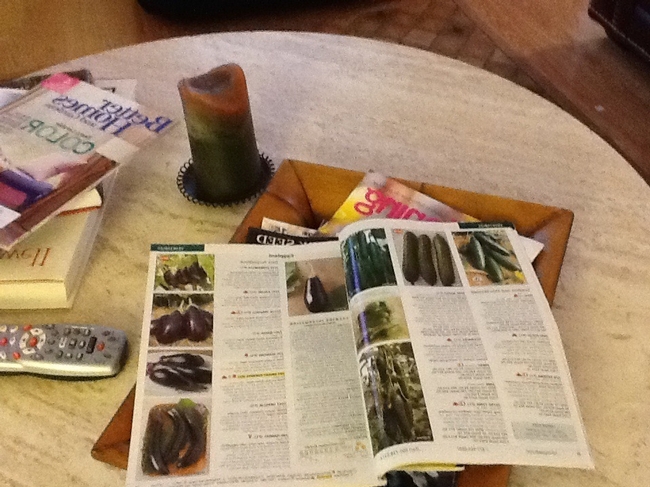
photo by Cheryl Potts
Posted on
Friday, February 15, 2013 at
7:49 AM
It's nice to remember the honey bee on Valentine's Day. You'll see many Valentine cards inscribed with "Bee My Valentine" and featuring a photo...
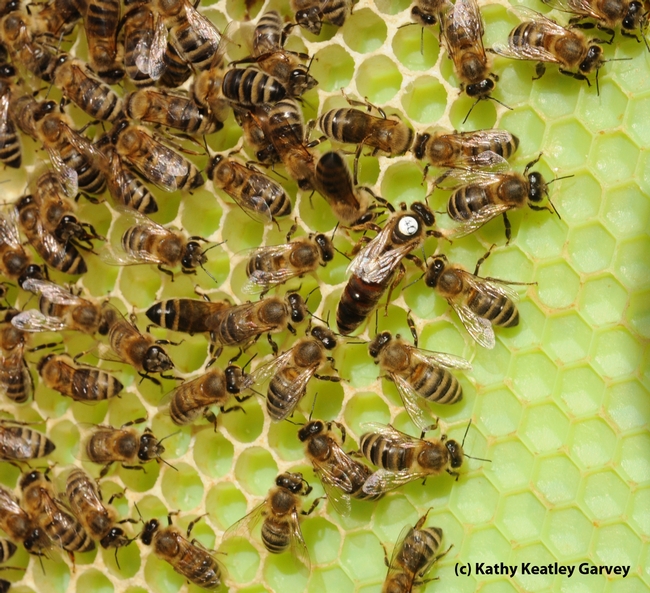
Queen bee (with dot) and worker bees. (Photo by Kathy Keatley Garvey)
Queen bee (with dot) and worker bees. (Photo by Kathy Keatley Garvey)
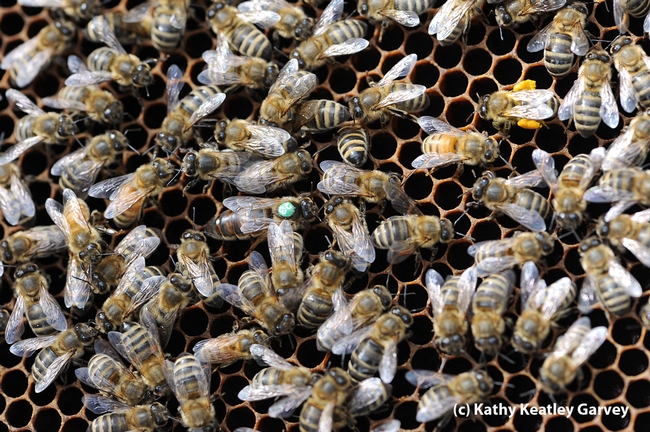
Another queen bee in the Harry H. Laidlaw Jr. Honey Bee Research Facility. (Photo by Kathy Keatley Garvey)
Another queen bee in the Harry H. Laidlaw Jr. Honey Bee Research Facility. (Photo by Kathy Keatley Garvey)
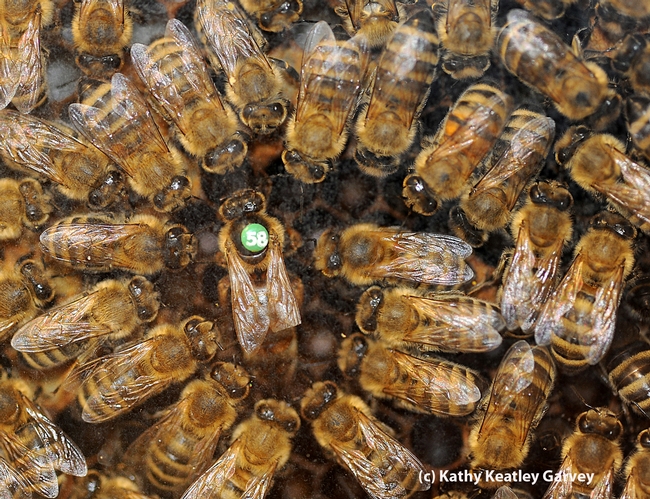
The queen and her retinue. (Photo by Kathy Keatley Garvey)
The queen and her retinue. (Photo by Kathy Keatley Garvey)
Posted on
Thursday, February 14, 2013 at
8:33 PM
Okay all you anxious gardeners now’s the time to start your tomato seeds indoors. It’s amazing that something not much bigger than the period at the end of this sentence can turn into something so interesting, tasty, fun, and _____________. You fill in the blank with your own description(s). Here is a little video I found on YouTube, to remind us what is to come and get your ‘juices’ flowing!
http://www.youtube.com/watch?v=LICDb8nM5rs
Enjoy!
Posted on
Thursday, February 14, 2013 at
3:26 PM
Plants communicate. They do.
Ecologist Richard Karban, a professor in the UC Davis Department of Entomology, points out that one of the simplest...
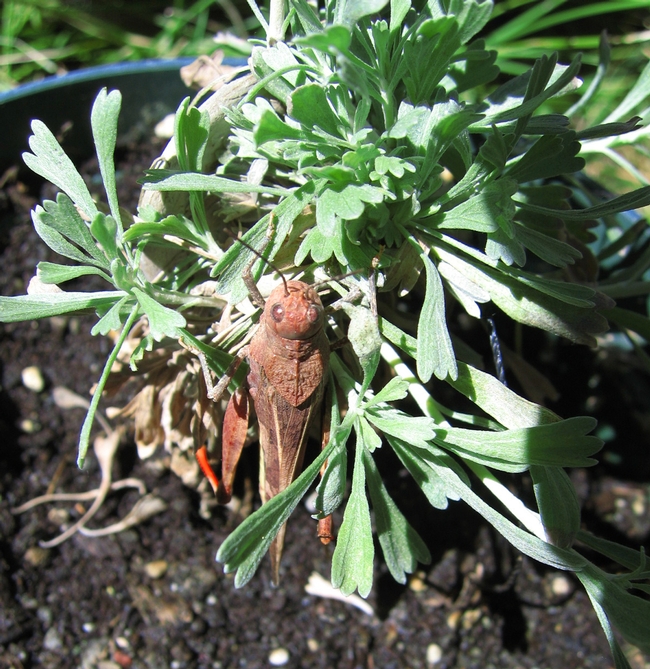
Grasshopper feeding on sagebrush. (Photo courtesy of Rick Karban)
Grasshopper feeding on sagebrush. (Photo courtesy of Rick Karban)
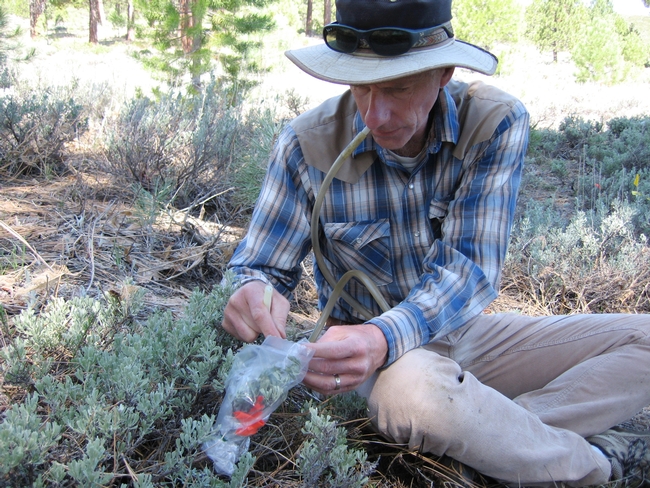
Rick Karban collecting volatile (chemical) cues.
Rick Karban collecting volatile (chemical) cues.
Posted on
Wednesday, February 13, 2013 at
8:43 PM








